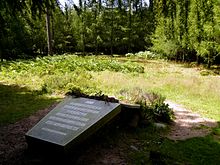|
Mont Sainte-Odile
     Mont Sainte-Odile (German: 'Odilienberg' or Ottilienberg; called Allitona in the 8th century) is a 764-metre-high peak in the Vosges Mountains in Alsace in France, immediately west of Barr. The mountain is named after Saint Odile. It has a monastery/convent at its top called the Hohenburg Abbey, and is notable also for its stone fortifications called "the Pagan Wall." In 1992, Air Inter Flight 148 crashed near this area. HistoryThe mountain and its surroundings contain evidence of Celtic settlements. The mountain enters recorded history during the Roman times; a fortress was supposedly destroyed by the Vandals in 407.[2] In the second half of the 9th century, when Vikings attacked the Low Countries, which had been recently converted to Christianity and were governed from Utrecht, the Utrecht bishops went into exile and stayed for a while in a convent in Sint-Odiliënberg in Limburg, named after Mont Sainte-Odile.[3] At least since the 19th century, its beauty has been celebrated[4] and the mountain, with convent and pagan wall, is often included in tourist guides,[5] incl. Baedeker's.[6] Hohenburg AbbeyThe convent is said to have been founded by Adalrich, Duke of Alsace, in honor of his daughter, Saint Odile, about the end of the 7th century, and it is certain that it existed at the time of Charlemagne. Destroyed during the Middle Ages, it was rebuilt by Premonstratensians at the beginning of the 17th century. It was acquired later by the bishop of Strasbourg, who restored the building and the adjoining church in 1853.[7] A famous manuscript, the Hortus Deliciarum, was compiled in the convent. The Pagan WallThe Pagan Wall (German: Heidenmauer, French: Mur païen) is a huge construction about 10 kilometres (6.2 mi) long which encircles Mont Sainte Odile. It is composed of about 300,000 blocks of Triassic conglomerates, between 1.6 metres (5.2 ft) and 1.8 metres (5.9 ft) wide and up to 3 metres (9.8 ft) high. The irregular shape of the wall coincides almost perfectly with the location of outcrops of its source material, minimizing the effort to transport the heavy blocks to their destination. The origins and date were disputed for a long time, with some claiming that it was a 3,000-year-old druid construction. Recent research has shown that it dates from the 7th century, about the time that the convent was built.[8] The designation "Pagan" is attributed to Pope Leo IX. In art and literatureA 2000 poem, "Return to St. Odilienberg, Easter 2000," by the American poet Claire Nicholas White, is inspired by the abbey.[9] See alsoReferences
External linksWikimedia Commons has media related to Mont Sainte-Odile. |
||||||||||||||||||||
Portal di Ensiklopedia Dunia

